In addition to the many recent books, articles and exhibition catalogues converging on the life and art of Vermeer, various video productions merit special mention. Vermeer was perhaps the most cinematic of all painters, with his mise-en-scène presentations perfectly toned in modern optical images. These videos showcase his art with appropriate cinematic force while providing interesting commentary.
- Dicht bij Vermeer (Close to Vermeer)
(2023 |)
- I Silenzi di Vermeer (Vermeer's Silences)
(2019 |)
- Mystery of the Lost Paintings: The Concert
(2018 |)
- Vermeer: Beyond Time
(2017 |)
- Vermeer and Music: The Art of Love and Leisure
(2013 |)
- Tim's Vermeer
(2013 |)
- Views on Vermeer: 12 Short Stories
(2009 |)
- Vermeer - Private Life of a Masterpiece
(2005 |)
- Girl with a Pearl Earring
(2004 |)
- Brush with Fate
(2002 |)
- The Madness of Vermeer
(2002 |)
- Love, Light and Silence
(2000 |)
- Vermeer, Master of Light
(2000 |)
Close to Vermeer - 2023
CLOSE TO VERMEER
Directed by Suzanne Raes
For trailer and information about tickets and viewing scedule in the United States, click here
Click here for an interview with Suzanne Raes
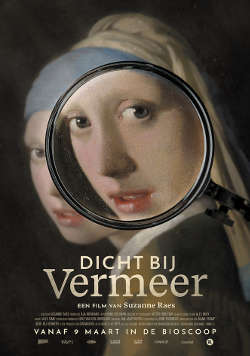
In Close to Vermeer, award-winning director Suzanne Raes gives us a unique insight into the realization of the largest Vermeer exhibition ever. She films Rijksmuseum curators Gregor Weber and Pieter Roelofs and conservators Abbie Vandivere and Anna Krekeler in their mission to shine a new light on Johannes Vermeer. For although The Milkmaid and Girl with a Pearl Earring are world-famous, we know little about the painter himself. No self-portraits, no letters, no notes; a small oeuvre is all that the Dutch Master left behind.
This fascinating documentary shows everything from the quiet diplomacy required to get the Vermeers to the Netherlands and the new knowledge gained by scanning the paintings layer by layer, to the shocking world news that one work may not be by Vermeer after all. Slowly we discover how Vermeer was able to depict reality so differently from his contemporaries. But above all, Close to Vermeer shows the infectious love of the curators and other protagonists for Vermeer’s art. As Weber lovingly puts it, "A good exhibition should change your view of the world. Vermeer can really do that."
Suzanne Raes studied Cultural Studies in Amsterdam and began her career as a researcher and chief editor for various television programs. Since 2001 she has worked as an independent director of creative documentaries on subjects such as illegal cleaners, old activists and artists. She makes accessible and engaging films that are screened worldwide and have a long life even after broadcast.
Reviews
- “Insightful and irresistible. A globe-trotting tale of diplomacy, a detective story and a fascinating insight into the insular world of museum curation, research and preservation, which helps keep culture alive through the march of history.”
– G. Allen Johnson, San Francisco Chronicle - “A gentle, thoughtful documentary populated by knowledgeable individuals, experts at the top of their fields who... help us to not just look at a Vermeer, but to see.”
– Sheila O'Malley, RogerEbert.com - “Chronicles the making of the exhibition that brought over half a million visitors to the Amsterdam museum… I felt a lot closer to the elusive Dutch master by the closing credits.”
– Maya Pontone, Hyperallergic - “Provides a fascinating behind-the-scenes glimpse of the drama that preceded the [exhibit’s] historic run.”
– Sarah Cascone, Artnet.com - “Anyone who loves to spend time in a gallery simply must see this documentary. Audiences can see the textures of Vermeer and the details of his work like never before. The film is like having the closest view possible in a gallery.”
– Pat Mullen, POV Magazine - “Allows us to… experience [the] rich details that would not be possible in a busy museum. Cuts through the crowd so that we can be up close and personal with the art. What we know about Vermeer is limited, but Close to Vermeer is a tribute to his talent that gives us the opportunity to see him and his work like never before.”
– Cassandra Bauer, Film Obsessive - “This intriguing documentary… spotlights the unique talent of the artist, the behind-the-scenes work of curators, and the ways in which Vermeer’s paintings still have a lasting impact centuries later.”
– Todd Jorgenson, Cinemalogue - “Riveting. The Rijksmuseum's Vermeer retrospective is nothing short of an historic event.”
– Alex Billington, First Showing
I Silenzi di Vermeer (Italian) - 2018

Writer and narrator: Tomaso Montanari
Producer: Land Comunicazioni
Broadcaster: Rai5
In this four episode series viewed on the Italian Cultural TV network, the Italian art historian Tomaso Montanari, who is well known for his brilliant multi-episode TV series on Caravaggio and Bernini, raccounts from inside out the story one of the great painters of seventeenth-century European art: Johannes Vermeer. Montanari argues that although Vermeer has become a household word through a flood of cinema and consumer literature, the painter's rock-star popularly has not promoted the understanding of the true scope of his art. Following canvas to canvas from Europe to America, Montanari builds his case with eloquence and erudition and succeeds in conveying the authentic and exceptional energy which animates Vermeer's "silent" art.
1. The poetry of every day -58 min.
2. The inside and the outside - 58 min.
3. Cartography of love - 53 min.
4. With other senses - 60 min.
Mystery of the Lost Paintings: The Concert - 2018
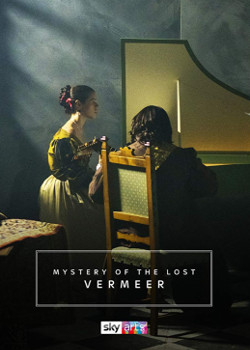
60 Minutes
2018
Broadcaster: Sky Arts Italia, Sky Arts UK, Sky Arts Deutschland
Producer: Sky Arts Production Hub
Seven masterpieces by seven great artists, all lost, stolen or destroyed under tragic circumstances are recreated thanks to the special skills of a team of artists, specialists, curators and cutting-edge technology. This series features one destroyed masterpiece in each episode and the story of the artists, the subject of the painting and the story behind its disappearance—leading up to its recreation. Paintings and artists include Johannes Vermeer's stolen The Concert, Graham Sutherland's portrait of Churchill, one of Van Gogh's four iconic paintings of sunflowers and a controversial Gustav Klimt piece.
The programme follows a team from the Spanish firm Factum Arte as they scan, print, paint and work to understand and recreate each painting. The hour-long episode about Vermeer's The Concert narrates the story of the artist, his painting, his technique and how it was lost. The episode includes comments by the author and webmaster of Essential Vermeer website, Jonathan Janson.
Vermeer: Beyond Time - 2017

Director: Jean-Pierre Cottet, Guillaume Cottet
Producer: James Mitchell
Coproduction: Martange Production (Paris), Soho Moon Pictures (Dublin), Arte France and the Louvre
Duration: 86 minutes
Release date; 2017
Initially shown in conjunction with the exhibition Vermeer and the Masters of Genre Painting: Inspiration and Rivalry, (Paris, Dublin and Washington D.C.) Vermeer, Beyond Time focuses on the artist's family life, his artistic contemporaries, his conversion to Catholicism, and the wider world of the seventeenth-century Dutch Golden Age.
Cottet's remarkable film, which is probably the best introduction to the enigmatic painter currently available, explores the individual paintings and teases out what has come to be known as the Vermeer style; the representation of light, the interplay of color and the effects of perspective across the same themes, places and objects.
purchase at PBS - https://amzn.to/40rDhm0
purchase at Amazon.com - https://amzn.to/40r06pM
Vermeer: Beyond Time - YouTube trailer
Vermeer and Music: The Art of Love and Leisure at the National Gallery, London - 2013
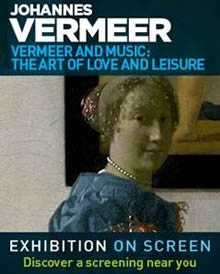
Production: Seventh Art Productions & Phil Grabsky Films
Directors: Phil Grabsky and Ben Harding
Film editor: Tom Thistlethwaite
Narrator: Tim Marlow
Commentators: Tracey Chevalier, Walter Liedtke, Taco Dibbits and others
Approximate run time: 85 minutes
Release date: October 2013
Billed as a revolutionary approach to experiencing traditional art, Vermeer and Music: the Art of Love and Leisure at the National Gallery, London is one of Exhibition on Screen's films about, Johannes Vermeer, one of the world's foremost and beloved artists.
The narrator, Tim Marlow—writer, broadcaster and art historian noted principally for the program Marlow On Style—accompanies viewers behind the scenes the London exhibition Vermeer and Music: The Art of Love and Leisure to tell the entire story of Vermeer's life. In doing so, many other of the artist's captivating works are captured in HD detail on film for the first time. Among various guests, Marlow interviews Tracy Chevalier, the author of the best-selling Girl with a Pearl Earring, a fictional novel exploring the woman behind the celebrated painting of the same name. Others interviewed ponder what Vermeer's paintings say about the role of music in the culture of his day. Eschewing speculations about Johannes Vermeer's use of optical devices to make his radiant paintings, the film delves into the role of music and musical instruments in his artworks and those of many contemporaries in the Dutch Golden Age.
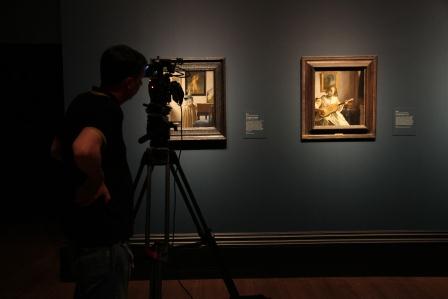
Tim Marlow comments, "I think that standing face-to-face with some of the greatest works of art ever made is one of the most powerful experiences in life. Exhibition on Screen gives us the opportunity to convey something of this power in a cinematic format which brings the viewer as close to the real thing as possible. Sometimes, the camera reveals even more than the naked eye ..."
Vermeer and Music was filmed in London, New York, where audiences are offered the first large screen images from the new Vermeer room at the Metropolitan Museum of where all five of their Vermeers hang together for the first time, and Washington, where four more works by Vermeer hang. Back in Europe, the film visits Amsterdam and then The Hague & Delft to explore these masterpieces such as the iconic Girl with a Pearl Earring.
The film was made by the arts documentary maker Phil Grabsky, who has launched a project to connect major exhibitions from across the world to a wider public. According to Grabsky, "So many people simply would never have a chance to see these exhibitions—nor, often, these paintings in such detail nor these artists' biographies in such an accessible and engaging way. I want to encourage people to go to galleries but if you live thousands of miles away or indeed are elderly, infirm or simply can't get child-care, then people are delighted with what we are doing."
Tim's Vermeer - 2013
Director: Penn Jillette
ProducerS: Penn Jillette and Farley Ziegler
Principal Cast: Penn Jillette, Tim Jenison, Martin Mull, Philip Steadman, David Hockney, Colin Blakemore
Cinematographer: Shane F. Kelly
Editor: Patrick Sheffield
Music: Conrad Pope
U.S. Distributor: Sony Pictures Classics
Canadian Dist.: Mongrel Media
Release date; 2013
Duration: 80 minutes
Production website: http://sonyclassics.com/timsvermeer/
In Tim's Vermeer, Tim Jenison, a Texas-based inventor and giant of video and post-production software for home computers, (Video Toaster, LightWave, TriCaster) attempts to solve one of the mysteries in European art: How did the seventeenth- century Dutch master Johannes Vermeer manage to paint so realistically - 150 years before the invention of photography?
In the search of an answer, Jenison began by working off of the theories set forth in David Hockney's Secret Knowledge: Rediscovering the Lost Techniques of the Old Masters and Philip Steadman's Vermeer's Camera: Uncovering the Truth behind the Masterpieces, both of which allege that Vermeer employed an optical device, the camera obscura, as an aid to his painting. Fascinated by the theories of Hockney and Steadman, Jenison built his own camera obscura but found something was amiss. He immediately came to suspect that not only had Vermeer used some sort of optical device to trace the drawing of his motif onto his canvas (as Steadman had shown) but must have used it to register the colors and tonal values of his paintings, which have been long admired for their verisimilitude, apparently out of reach of his contemporaries.
Although Jenison admits that there is no historical evidence that might prove his hypothesis, but he believes if his method for transferring form, color and tone form with a mechanical device to a canvas were used by Vermeer, a chapter of art history would have to be revised.
Views on Vermeer: 12 Short Stories - 2009
Director: Hans Pool
Cinematography: Hans Pool
Screenplay: Koos de Wilt
Editing: Maaik Krijgsman
Sound: Jan Wouter Stam
Production: Martin Lagestee for Lagestee Film BV
Involved TV Channel: AVRO
Duration:52 minutes
Format: Color HD
Views on Vermeer is a documentary devoted to the art Johannes Vermeer. Over the course of 12 chapters, four contemporary photographers, three artists, three writers, two curators, an architect, an art dealer and an art historian discuss their admiration for his work. Among them is Tracy Chevalier, author of the historical novel Girl with a Pearl Earring (the film version of which was directed by Peter Webber); American photojournalist Steve McCurry, who shot the famous Afghan Girl portrait; American artist Chuck Close; and the Dutch photographer Erwin Olaf.
Each chapter focuses on a particular quality of Vermeer's work, helping the audience to look upon it with new eyes: from the way he painted bricks to the hidden political subject matter, by way of the tableaux he chose to depict. Views on Vermeer also explores the probability that he used a camera obscura when painting. The Vermeer aficionados are filmed in their own natural habitat with their own work or that of the painter's close at hand, and accompanied by their "own" musical theme. Vermeer comes into relief as a direct precursor of photography and cinema, as well as a continuing and important inspiration for contemporary fine arts.
interviews with:
- Geoffrey Batchen - art historian
- Alain de Botton - writer/philosopher
- Chuck Close - artist
- Philip-Lorca di Corcia - photographer
- Tracy Chevalier - writer
- Steve McCurry - photographer
- Tom Hunter - artist
- Jonathan Janson - painter/ author of Essential Vermeer
- Thomas Kaplan - art collector
- Walter Liedtke - art historian
- Joel Meterowitx - photographer
- Otto Naumann - art dealer
- Erwin Olaf - photographer
- Philip Steadman - architect
- Peter Webber - film director
- Lawrence Weschler - writer
- Arthur K. Wheelock - art historian
Reviews
- "VIEWS ON VERMEER provides thought provoking viewing for both the general and academic audience, and offers a gentle, comfortable 'exercise of the brain' that sparks a desire for more contemplation and discussion."
Educational Media Reviews Online, February 2012 - "Much of the film is quite marvelous: relaxed yet lively, modest but confident. It's like a series of bracing conversations about an endlessly interesting subject."
Mark Feeney, The Boston Globe - "VIEWS ON VERMEER is a delightful, impressionistic meditation on the many ways the elusive and allusive Vermeer continues to inform, inspire and provoke the contemporary imagination." - The Globe and Mail
Vermeer - Private Life of a Masterpiece (BBC Documentary) - 2005
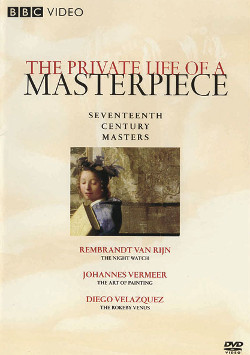
Screenwriter: John Bush Director
Director: Lucie Donahue
Producer: Mick Gold Director
Executive Producer: Jeremy Bugler
Screenwriter: Russell T. Davies
Voice: Samuel West
Duration:50 minutes
Format: Color HD
The Private Life of a Masterpiece was a BBC arts documentary series which told the stories behind great works of art; 29 episodes of the series were broadcast on BBC Two, commencing in 2001 and ending in 2010. It initially ran for five seasons from 2001 to 2006, for a total of 22 episodes; each episode was 50 minutes long. A further seven episodes were broadcast between 2006 and 2010.
The Private Life of Vermeer traces the afterlife of artist's mid-career master piece, The Art of Painting. it is highly likely that Vermeer created the elaborate composition as a sort of showcase painting which would impress potential clients and at the same time provide a testimony to the high ethical stature of the painter. It would appear that Vermeer's wife, Catharina Bolnes, went to great lengths to conserve her husband's masterpiece from creditors after the untimely death of the artist. The Art of Painting later proved the favorite of Adolf Hitler, who bought it over the head of a rival buyer, Field Marshall Herman Goering. After WWII, the American army was rescued the precious work from the Alt Aussee salt mine in Austria where Hitler had stored it for safe keeping. The Americans presented the painting to the Austrian Government in 1946, and after lengthy legal discussions regarding its ownership, it now the property of the State of Austria.
Girl with a Pearl Earring - (2004)
Actors: Scarlett Johansson, Colin Firth, Tom Wilkinson, Judy Parfitt, Cillian Murphy
Directors: Peter Webber
Writers: Tracy Chevalier (novel), Olivia Hetreed (screenplay)
Producers: Anand Tucker, Andy Paterson, Anna Campeau, Bob Bellion, Cameron McCracken
Run Time: 100 minutes
The subject of one of Johannes Vermeer's most enduring portraits becomes the focus of this biographical period piece from director Peter Webber. Girl With a Pearl Earring is told from the point of view of Griet (Scarlett Johansson), a teenaged girl who leaves her family's care in the country to become a servant for the Vermeer household in the comparatively bustling, canal-laden burgh of Delft. When she arrives, she finds herself at the low end of the servant totem pole, until she's allowed to clean "the master's" painting quarters. There, she catches the eye of the taciturn, reclusive Vermeer (Colin Firth), and over a period of time, he begins to craft her portrait. Of course, this does little to further his relationship with his jealous, pregnant wife, Catharina (Essie Davis), or with his most vocal benefactor, van Ruijven (Tom Wilkinson), who often dictates what portraits Vermeer should paint. Meanwhile, Griet navigates a sweet, tentative relationship with a peasant boy her age (Cillian Murphy).
—Michael Hastings, Rovi
Girl With a Pearl Earring had its North American premiere at the 2003 Toronto Film Festival.

Brush with Fate - (2002)
Director: Brent Shields
Writers: Susan Vreeland (novel), Richard Russo (teleplay)
Actors: Ellen Burstyn, Glenn Close, Thomas Gibson
Cinematography: Eric Noman Van Haren
Running time: 100 minutes
Produced: Cameron Johann and Thomas John Kane
Painting:" Jonathan Janson
A Hallmark Fall of Fame production based on the novel by Susan Vreeland, Girl in Hyacinth Blue
A riveting mystery traces a priceless masterpiece through three centuries. For generations, a "lost" Vermeer painting has passed between owners, changing the fate of all who have possessed it...whether bought in passion, sold in desperation or stolen in greed. An eccentric school teacher (Glenn Close), who secretly possesses the painting today, has devoted her life to researching its history. When she decides to share the story of the painting with a fellow teacher (Thomas Gibson), this 300-year-old mystery begins to unravel.

Jonathan Janson
2001
(© Hallmark Hall of Fame)
The imaginary painting of Brush with Fate (image above), the principal object of the film, was painted in Vermeer's painting technique by the American painter Jonathan Janson, author and webmaster of the Essential Vermeer website.
The Madness of Vermeer - 2002
Production: BBC Two
Presenter: Andrew Graham-Dixon
Producer: Roger Parsons
Duration: 60 minutes
Secret Lives of the Artists is a British documentary series which forms part of the BBC Two's "Imagination" art strand, in which art historian Andrew Graham-Dixon sets out to investigate the "secret lives" of three artists: Constable, Vermeer and Caravaggio.
"Looking for Vermeer is a pastime bordering on obsession," presenter Andrew Graham-Dixon comments. "Madness is the last thing associated with Vermeer's work, but I'm interested in the passions that run beneath the calm waters of his art." In fact, according to Graham-Dixon, recent archival research reveals a reality far removed from the idealized settings of Vermeer's paintings, which portray a life of peace and domestic bliss.
Born to Protestant parents in Delft in 1632, Vermeer's family life was anything but peaceful: his grandmother ran an illegal lottery and often ran into trouble with the police; and his grandfather was imprisoned for counterfeiting coins. His wife's relatives—a well-to-do Catholic family—also had their share of difficulties. Records show that Catharina's mother, Maria Thins, was often beaten by her husband and that the family finally split up acrimoniously.
Against this backdrop, it becomes easier to understand why Vermeer chose to capture moments of serenity in his paintings.
Vermeer achieved some success as a painter during his lifetime, becoming the head of the Saint Luke's Guild in 1662. Ten years later, in 1672, his fortunes were to change with the invasion of Holland by the French army. As a defense, the Dutch decided to flood their own land, which destroyed the homes rented out by Vermeer's mother-in-law. Their family income plummeted and the art market nose-dived. A year later, Vermeer's patron died.
His wife's relatives—a well-to-do Catholic family—also had their share of difficulties. Records show that Catharina's mother, Maria Thins, was often beaten by her husband and that the family finally split up acrimoniously.
Set adrift from a regular supply of money, Vermeer descended into debt and despair and even cheated his mother-in-law out of some cash. He died penniless in 1675, aged 43.
Love, Light and Silence - 2000
reviewed by Jon Boone - August 6, 2003
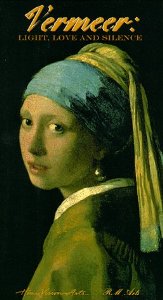
Director/Producer: Michael Gill
Producing Agency: RM Arts; London Weekend Television; Malone Gill
Format: Color, NTSC
Studio: Homevision
VHS Release Date: June 13, 2000
Run Time: 50 minutes
Of the two the most visually compelling is Light, Love, and Silence (RM Arts), written, produced and directed by Michael Gill in time for the 1995–1996 Washington-The Hague exhibition. Here Vermeer's paintings are presented in vibrant color and convincing depth. Arthur K. Wheelock Jr. and Jørgen Wadum provide excellent insights as they examine such works as The Milkmaid, View of Delft, The Little Street, and the Girl with a Pearl Earring, while the camera illustrates their remarks with breathtaking images. Wheelock gives a wonderful coda to the video with a brief discussion about the merits of one of Vermeer's late works, The Guitar Player. Other experts contribute telling details about Dutch history, the camera obscura, and the work of Anthony van Leeuwenhoek, Vermeer's near neighbor. Using The Music Lesson, Wadum explains how Vermeer augmented his perspective scheme with pins and strings stretched from the central vanishing point of the painting.
Several charmingly erudite discussions ensue between the British dramaturge, Jonathon Miller, and the art/intellectual historian, Svetlana Alpers, excellent bridges connecting and helping focus the many elements of the production. Alpers talks about the importance of maps to the Dutch culture while Miller probes some of the psychological implications of Vermeer's studies. Their banter exemplifies an enlightened conviviality worthy of the master, made even more meaningful because of the way the camera cuts away to show relevant images of the paintings under discussion.
Edited and narrated by Melvyn Bragg, the production maintains a kinetic quality during its 52 minutes, always on the move, each scene gradually poised to flow naturally into the next. One can't emphasize enough how beautiful and vivid the paintings appear—much more so than any photographic reproduction. These images alone more than justify the modest cost of the video. The narrative is resolute and usually clear, with only one questionable comment: In a discussion about the Dutch desire for privacy, Bragg recounts how a French dignitary (the Baron de Monconys) had visited Vermeer's studio to see some of the artist's paintings, only to be informed there were none to see, when in fact "he had a roomful next door." This last statement seems in error, for while Vermeer's patron (Pieter van Ruijven) doubtless had a roomful of the artist's paintings at the time of the incident (1663), his house was not in Vermeer's immediate neighborhood.
Vermeer, Master of Light - 2000
reviewed by Jon Boone - August 6, 2003
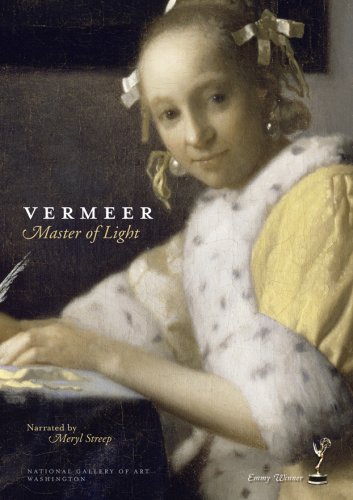
Narrator: Meryl Streep
Director: Joseph Krakora
Format: Color, NTSC
Language: English
Region: All Regions
Aspect Ratio: 1.33:1
Number of discs: 1
Rated: NR (Not Rated)
Studio: Microcinema International
DVD Release Date: January 1, 2008
Run Time: 57 minutes
Light, Love, and Silence belongs in every art lover's library to be enjoyed for itself and to complement other, more traditional sources of information.
It is also a fitting prelude to the video which the National Gallery of Art in Washington released last year (2002): Vermeer, Master of Light, narrated by Mary Streep and directed by Joseph J. Krakora. Vermeer, Master of Light opens to the peeling carillons of the New Church at dawn over Delft as the camera pans scenes of the city given form by the spreading light. Streep's familiar voice moderates the commentary interspersed throughout the 57 minute production. As the curator of Northern Baroque Art at the National Gallery, Arthur K. Wheelock Jr. anchors the expert analysis, while the museum's senior consultant for conservation, David Bull, highlights the importance of conservation/restoration methods and techniques as tools for upholding Vermeer's artistic intentions. Harvard's venerable Seymour Slive rounds out this pundit trio, probing the special qualities of Vermeer's oeuvre. Together the scholars, using sophisticated computer enhancements, examine a number of the artist's works in detail, reviewing Vermeer's painting techniques and compositions, then demonstrating how particular paintings were crafted.
Wheelock is splendid as he talks about the Woman Holding a Balance, the Woman in Blue Reading, A Lady Writing. One of the delights of the video is to see Wheelock actually holding the unframed original of the Girl with the Red Hat. Streep's narratives on The Music Lesson and the Girl with the Red Hat form the centerpiece of this production. Here Vermeer's artistry is investigated in a step-by-step account of each painting in ways which allow the viewer to understand at least some of Vermeer's expressive accomplishments. This is art history at its best, marred only by a rather misinformed attempt in The Music Lesson to explain background shadows in the painting as the consequence of artistic license rather than a rather straightforward depiction of the actual shadows created by north light from the windows.
This video is suffused with a reverential tone, perhaps too much so. Slive's remarks in particular seem defensive as he clearly seeks to protect his own special version of Vermeer. In a rather considered effort to disparage the idea that Vermeer relied heavily upon the camera obscura, even to the point of projecting scenes he orchestrated in the camera lens directly onto his canvas, Slive plangently argues that Vermeer "is not an ape of nature." He points to the "missing" left easel leg in The Art of Painting and the "great vault" of sky in the View of Delft as examples of Vermeer's independence from what could be seen through a camera obscura. He infers from the artist's paintings that "Vermeer is a man of great dignity."
But the research of people like Philip Steadman cannot be so easily dismissed. For at least six of Vermeer's paintings, Steadman has demonstrated that the master did in fact trace what he saw projected through the camera's lens, certainly to establish the basic compositional template as well as the essential tonal grid. However, no one, Steadman least of all, has suggested that Vermeer did not emend what he saw in front of him in pursuit of artistic expressiveness. The clouds, the shadows in the harbor, and above all the lighting schema throughout the city in the View of Delft were definitely created for artistic effect; but they appear nonetheless forged from the foundation seen in his camera. The "missing" easel leg in The Art of Painting, moreover, is not really missing; it is hidden behind the artist's left leg and his stool.
Vermeer may have indeed been dignified, but it is unlikely he was stuffy. As the son of an innkeeper/tavern owner who himself doubtless helped his mother run the tavern throughout much of his adult life and who was married at twenty, fathering fifteen children in twenty-two years of marriage, it is difficult to believe Vermeer was a strait-laced gentleman. The man who likely painted himself in such a bawdy pose in The Procuress; who, as Walter Liedtke has noted, painted The Milkmaid with suggestive innuendo; who gave the world the Officer and Laughing Girl, The Glass of Wine, The Girl with the Wine Glass, and the Girl with a Pearl Earring; who, in The Art of Painting, presented an allegory of the artist with drooping drawers and a manuscript hand fondling his backside—this was a man whose art transcends moral pigeonholing. Like Shakespeare, Vermeer's sensibility is richly protean, malleable and complex.
With notable exceptions, there was a general lack of vivacity in this film, at least by contrast with the earlier video. View of Delft had a distinct yellowish tinge, as did the Woman in Blue Reading, while the close-ups of the Girl with the Red Hat made the painting appear flat and listless. Vermeer, Master of Light would have benefited from the camera work which brought Light, Love, and Silence to life.
These quibbles aside, the National Gallery production is a desideratum for anyone interested in art and the creative process. It is an expressive companion to Michael Gill's video; but it also achieves very ambitious goals for itself. Wheelock's analysis, along with Bull's clarifying comments—and even Slive's passionate admiration—shed considerable light on Vermeer's genius.
Arthur K. Wheelock Jr. is clearly the guiding intelligence behind both these extraordinary offerings. For nearly three decades, this scholar has perhaps done more than any other to bring Vermeer and his art to the attention of the world. His lectures and writings, his curatorial skills, including the incredible exhibit in 1995, and his exhibition catalogues have reached and influenced millions of people, enlarging their knowledge of Vermeer in particular and the arts generally. With these videos, we continue to reap the generous harvest he sows.